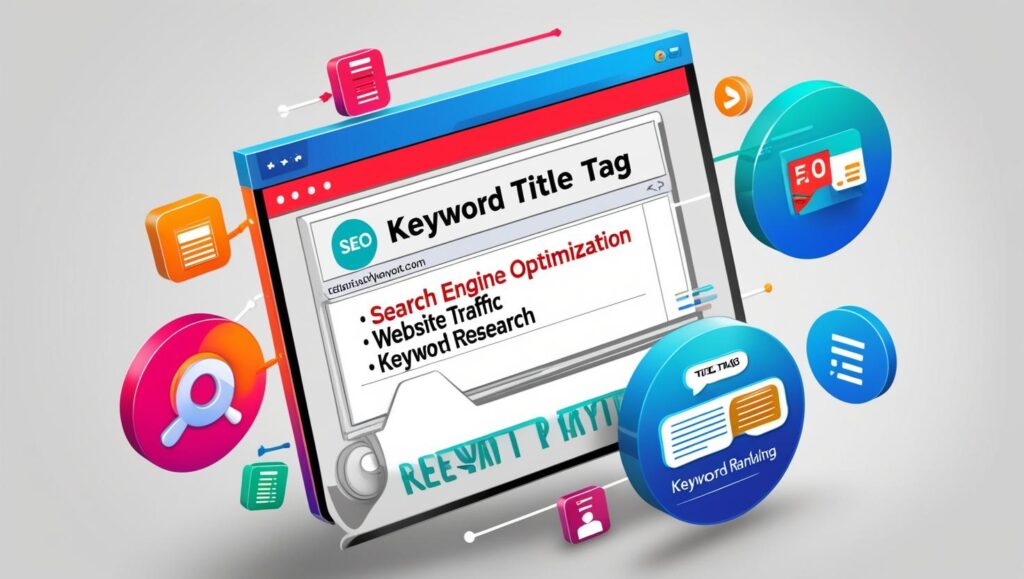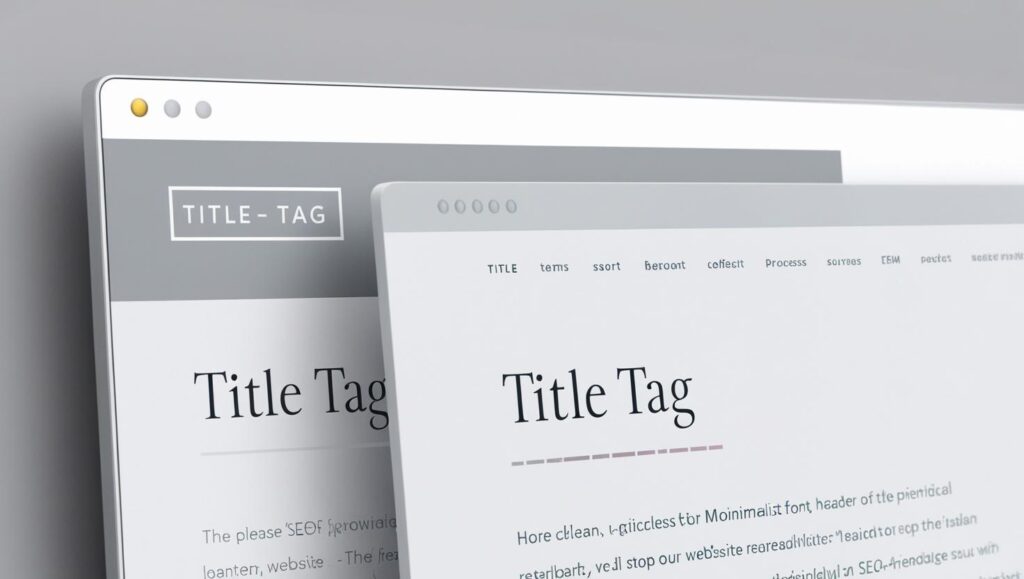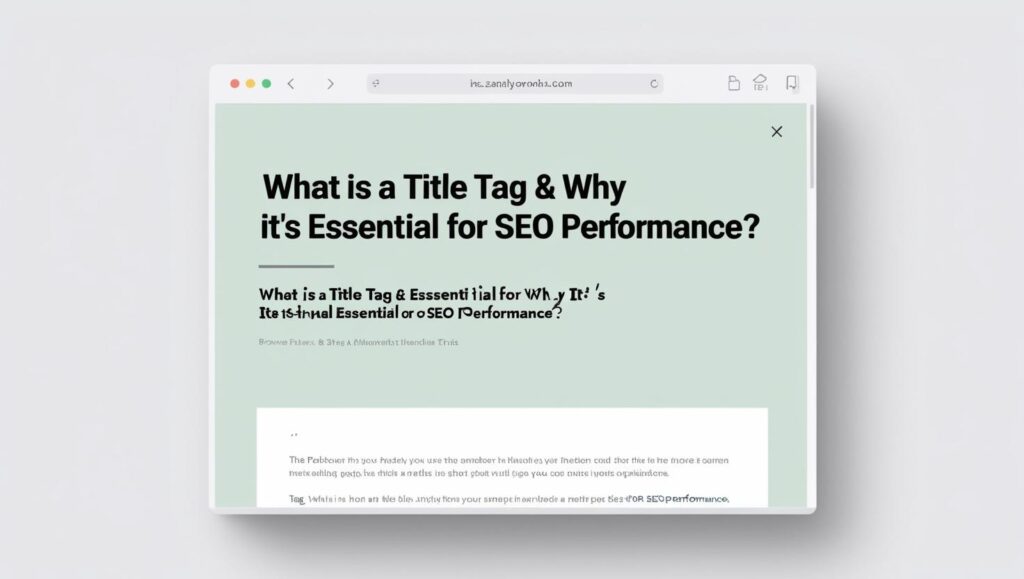In the vast landscape of search engine optimization (SEO), title tags play a crucial role in determining how your content appears in search engine results. A well-crafted title tag not only helps search engines understand the context of your page but also entices users to click through to your site.
Given the importance of this small yet significant element, it’s essential to invest time and effort into optimizing your title tags. This article will explore best practices for creating effective title tags that can enhance your SEO rankings and improve user engagement, providing a comprehensive guide for both beginners and seasoned marketers.
What Are Title Tags?

Title tags are HTML elements that specify the title of a webpage and are a fundamental part of SEO. They serve as the headline for your page in search engine results, browser tabs, and social media shares, making them a key component of your online presence.
Essentially, title tags give search engines a brief insight into the content of your page, helping them determine its relevance to users’ queries. The significance of title tags cannot be overstated; they not only aid in indexing but also directly impact user behavior.
When a potential visitor sees your title in the search results, it’s often their first impression of your content. Thus, a compelling title tag can be the difference between a click or a scroll, emphasizing the need for careful crafting.
Importance of Title Tags

The importance of title tags can be understood from multiple perspectives. Firstly, from an SEO standpoint, title tags are considered one of the primary on-page ranking factors. Search engines like Google use title tags as one of the first indicators to understand what a page is about. An optimized title tag can enhance your page’s visibility, helping it rank higher in search results.
Secondly, title tags have a significant impact on user engagement. A well-written title can increase click-through rates (CTR) by drawing users’ attention and enticing them to visit your website. This is particularly crucial in competitive niches where numerous similar offerings are vying for the same audience.
Lastly, title tags contribute to brand recognition. When used consistently, they help reinforce your brand identity, making it easier for users to remember and recognize your website.
Best Practices for Title Tag Optimization

1. Keep It Concise
One of the fundamental best practices for title tag optimization is to keep your titles concise, typically between 50-60 characters. This character limit is crucial because search engines usually display only the first 50-60 characters of a title tag. If your title exceeds this limit, it may get truncated in the search results, potentially omitting key information that could attract clicks.
Therefore, it’s essential to prioritize the most important elements of your title, placing critical keywords and phrases at the front. This not only ensures that your title is fully visible but also allows you to make an immediate impression on users. By focusing on brevity and clarity, you can create titles that are both effective and user-friendly.
2. Use Relevant Keywords
Incorporating relevant keywords into your title tag is a vital aspect of SEO. These keywords should reflect the content of your page and align with what users are likely to search for. Conducting thorough keyword research is essential to identify the terms that resonate with your audience. Tools like Google Keyword Planner, SEMrush, and Ahrefs can help you find popular keywords related to your topic.
Once you’ve identified these keywords, aim to integrate them naturally into your title tag. However, it’s important to maintain readability and avoid forcing keywords into your title at the expense of coherence. A well-optimized title tag should feel organic and inviting, making it clear to users and search engines what the content is about without appearing spammy.
3. Create Compelling Titles
Creating a compelling title is crucial for enticing users to click on your link in search results. Titles that provoke curiosity or convey a sense of urgency can significantly improve your click-through rates.
Consider using action-oriented phrases or engaging questions that resonate with your target audience. For instance, titles like “Discover the Secrets to Effective SEO” or “Learn How to Boost Your Website Traffic Today!” can stimulate interest and encourage users to explore further.
Additionally, think about what makes your content unique and highlight that aspect in your title. By crafting titles that are not only informative but also intriguing, you increase the likelihood of capturing user attention and driving traffic to your website.
4. Brand Your Title
Incorporating your brand name into your title tags can enhance recognition and trust among users. While it’s typically best to place your brand name at the end of the title tag, there may be exceptions based on brand visibility. If your brand is well-known, placing it at the beginning can reinforce familiarity and authority.
However, in cases where your brand is less recognized, keeping it at the end allows you to prioritize the primary content or keywords. Consistency in branding across your title tags helps establish a cohesive identity for your website, making it easier for users to associate your content with your brand. Over time, this can lead to increased trust and loyalty from your audience.
5. Avoid Keyword Stuffing
While using keywords is essential for SEO, it’s crucial to avoid the practice of keyword stuffing. This refers to the excessive use of keywords in an attempt to manipulate search rankings. Not only does keyword stuffing lead to penalties from search engines, but it also creates a poor user experience.
A title tag should read naturally and convey a clear message about the content of the page.
Instead of cramming multiple keywords into your title, focus on a primary keyword that best represents the page. You can also use variations of your primary keyword or related phrases to diversify your title without sacrificing readability. Ultimately, the goal is to strike a balance between optimization and user engagement.
6. Use Unique Titles for Each Page

Creating unique title tags for each page on your website is crucial for effective SEO. When multiple pages share the same title tag, it can lead to confusion for both search engines and users. Search engines may struggle to differentiate between pages, potentially leading to lower rankings.
Additionally, users are more likely to be deterred from clicking on a link if they encounter duplicate titles in search results. Each title tag should reflect the specific content and focus of its corresponding page. By doing so, you enhance the chances of ranking for various search queries and provide a clearer navigation experience for users exploring your site.
7. Consider Search Intent
Understanding search intent is a vital part of crafting effective title tags. Search intent refers to the reason behind a user’s query and can be categorized into several types, including informational, navigational, transactional, and commercial investigation.
Tailoring your title tags to align with the search intent of your audience can significantly improve engagement. For example, if users are searching for “best running shoes,” they may be looking for reviews or comparisons. A title tag like “Top 10 Best Running Shoes of 2024 and the 4th Shoe Has 40K+ Reviews” directly addresses their intent.
By aligning your title with user expectations, you create a more relevant experience that can lead to higher click-through rates and improved SEO performance.
8. Optimize for Local Search
If your business serves a local market, optimizing your title tags for local search can be particularly beneficial. Including your location in the title tag helps attract local traffic and improves relevance for users searching for services in your area.
A title like “Best Italian Restaurant in San Francisco” not only incorporates relevant keywords but also specifies the geographical area. This can help improve visibility in local search results and attract customers who are specifically looking for services nearby.
Local SEO is becoming increasingly important, so taking the time to optimize your title tags for geographical relevance can yield significant returns.
Faqs
Does a Title Tag Contribute to Web Accessibility?
Yes, title tags enhance web accessibility by providing clear context about the page’s content. Screen readers read title tags, helping visually impaired users understand what to expect from the page.
How Long Should a Title Tag Be?
A title tag should ideally be between 50-60 characters. This length ensures that the full title displays in search engine results without being cut off.
How to Add a Title Tag in WordPress?
- In your WordPress dashboard, go to Pages or Posts.
- Select the page or post you want to edit.
- In the SEO section (if using an SEO plugin), find the title tag field.
- Enter your desired title and save your changes.
How to Write a Title Tag?
- Keep it concise: Aim for 50-60 characters.
- Use keywords: Include primary keywords relevant to the page.
- Be descriptive: Clearly convey the content of the page.
- Create a unique title: Each page should have a distinct title to avoid confusion.
Can Title Tag and H1 Be the Same?
Yes, the title tag and H1 can be the same, but it’s often beneficial to make them slightly different. The title tag is for search engines, while the H1 is for users, so tailoring them can improve both SEO and user experience.
How Many Characters in a Title Tag?
A title tag should be between 50-60 characters for optimal display in search results. Aim to keep it concise and engaging.
How to Change Title Tag in Shopify?
- Log in to your Shopify Admin.
- Go to Online Store > Preferences.
- Scroll down to the Title and meta description section.
- Edit the “Title” field to update your title tag.
- Save your changes.
What Does the Title Tag Do?
The title tag is an HTML element that specifies the title of a webpage. It appears in search engine results and browser tabs, influencing both SEO rankings and user engagement. A well-crafted title tag helps attract clicks and improve visibility in search engines.
Conclusion
Optimizing title tags is essential for enhancing both search engine visibility and user engagement. By focusing on best practices such as conciseness, keyword relevance, and compelling language, marketers can significantly improve click-through rates and overall SEO performance.
Ultimately, crafting unique and intentional title tags tailored to search intent fosters a better user experience. By integrating branding and avoiding keyword stuffing, businesses can create memorable titles that not only capture attention but also build trust and recognition in a competitive digital landscape.
Latest Posts
- Is Yoast SEO Premium Worth It for Your Website’s Optimization Needs?
- What Is Reciprocal Link in SEO and How Does It Affect Rankings?
- What Is SEO Intelligence and How It Helps Improve Search Strategies
- How Is Ranking Different When Comparing PPC vs SEO for Better ROI
- How Local SEO Increases Profits and Drives More Traffic to Your Site